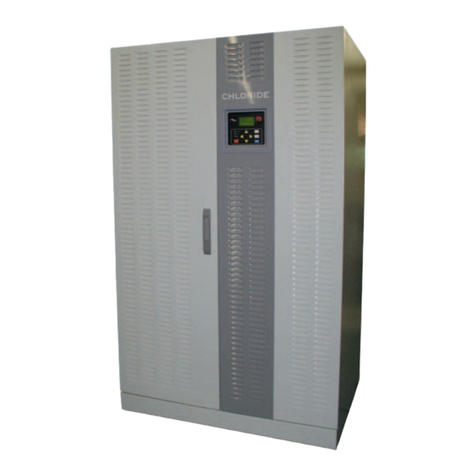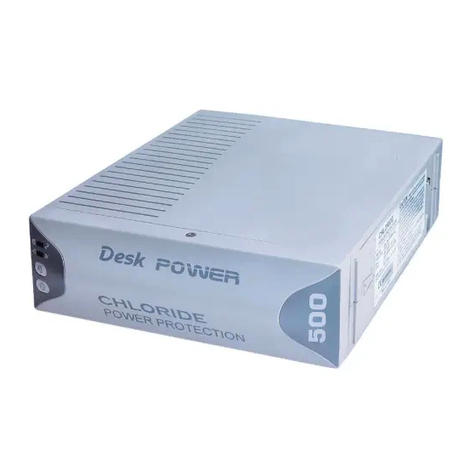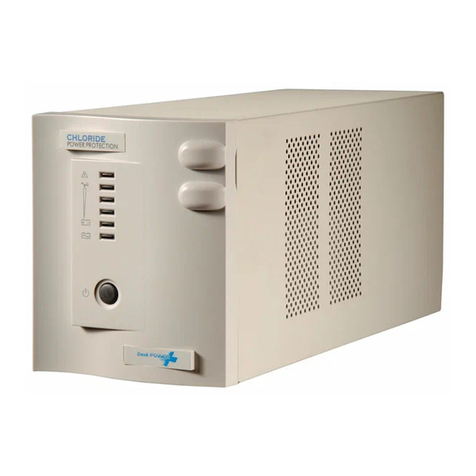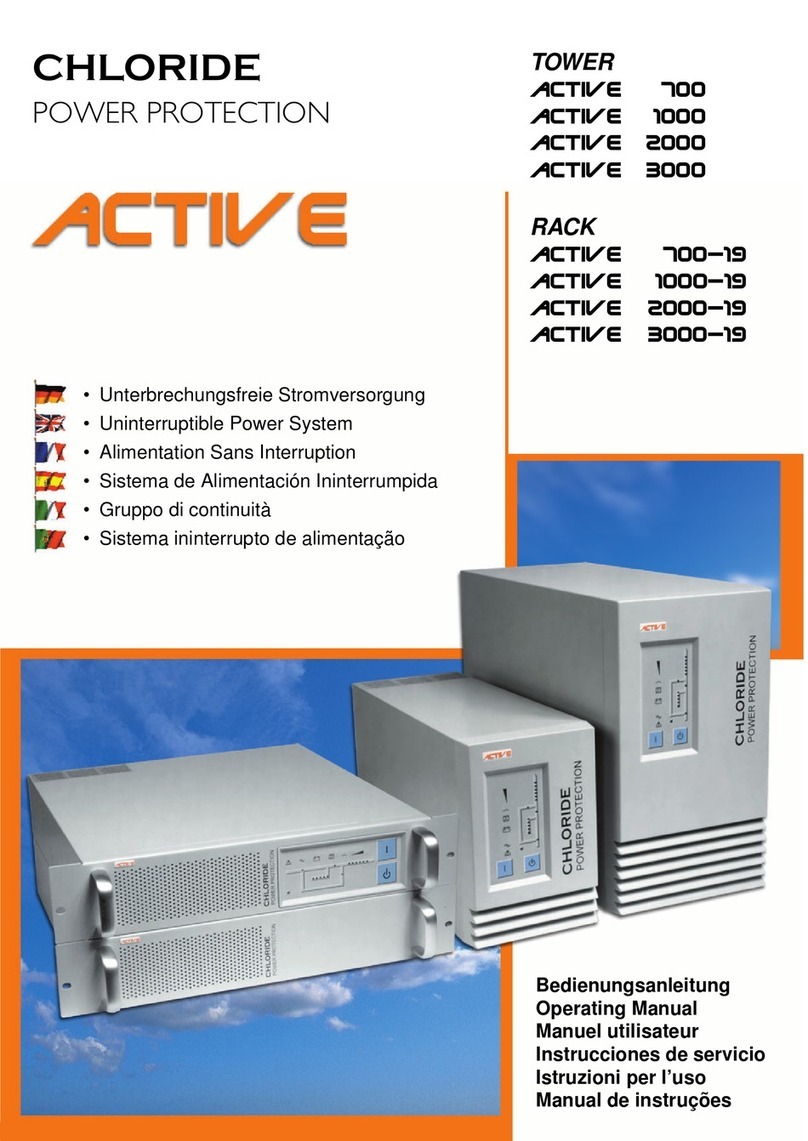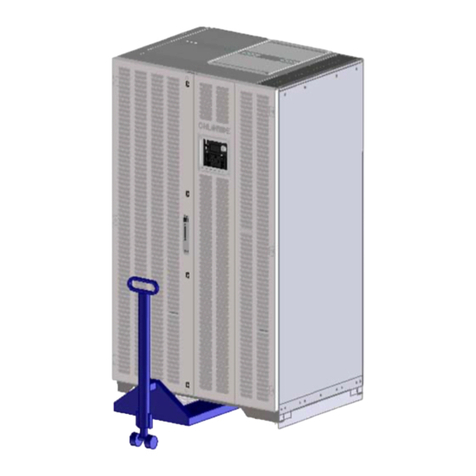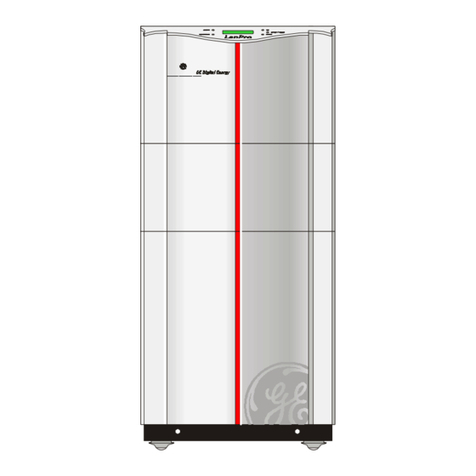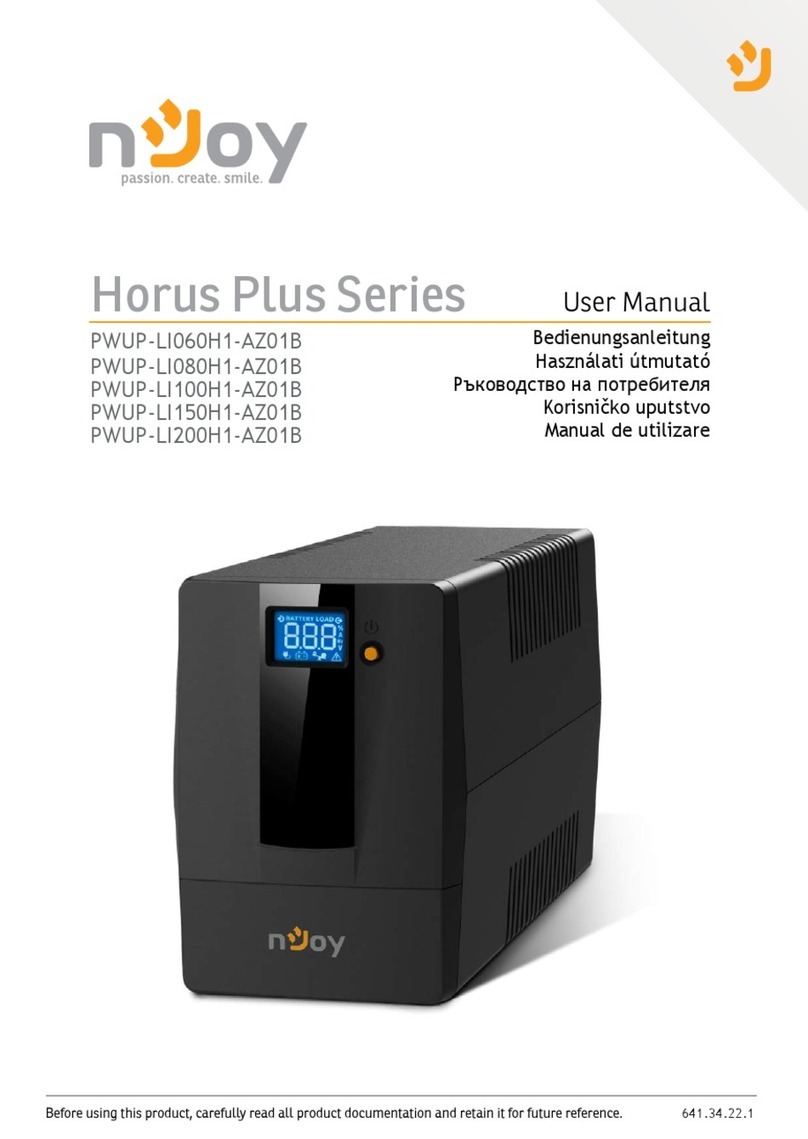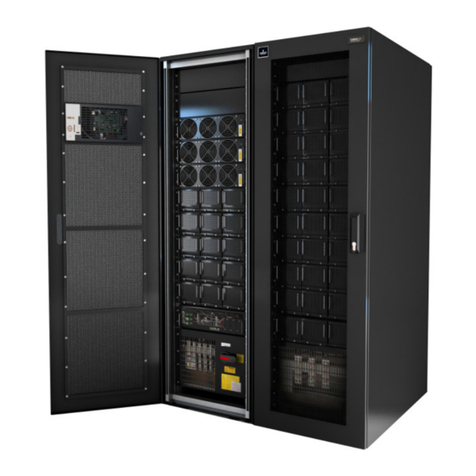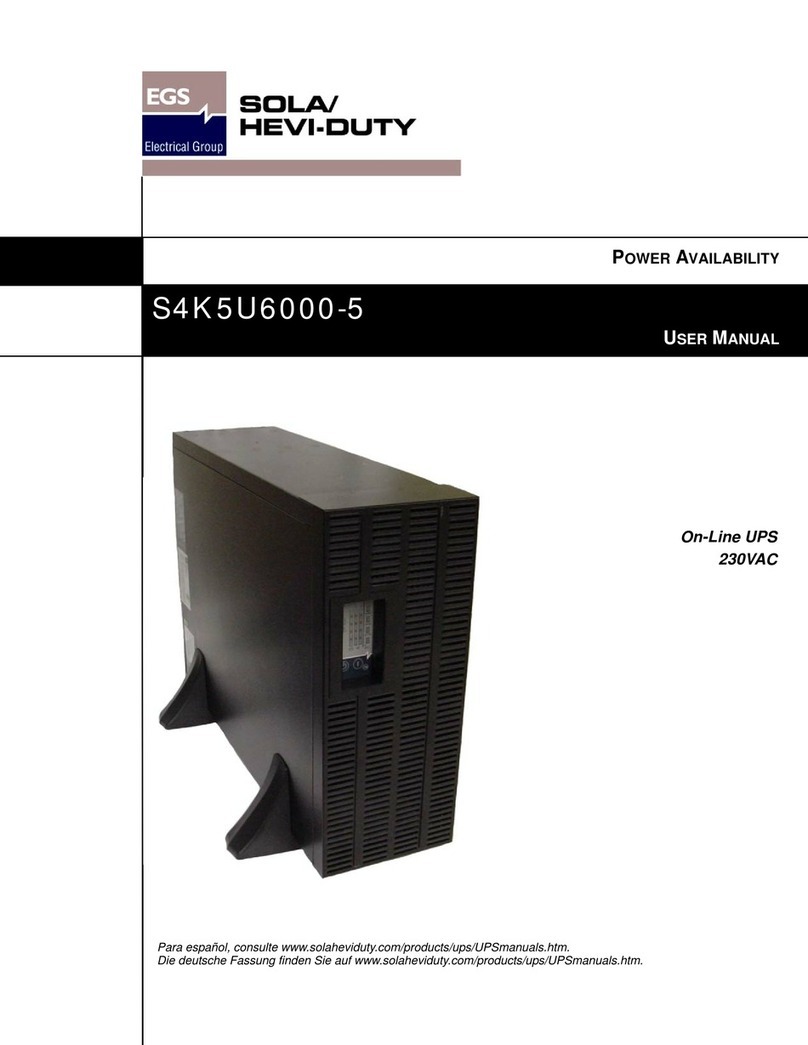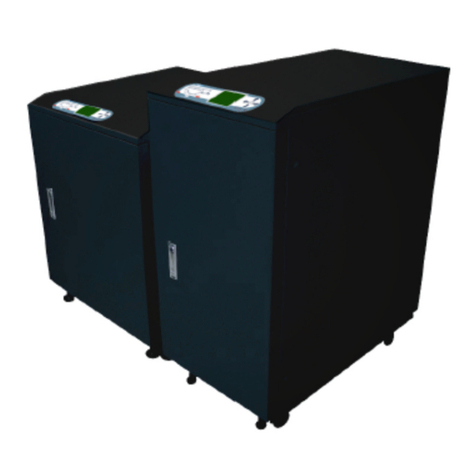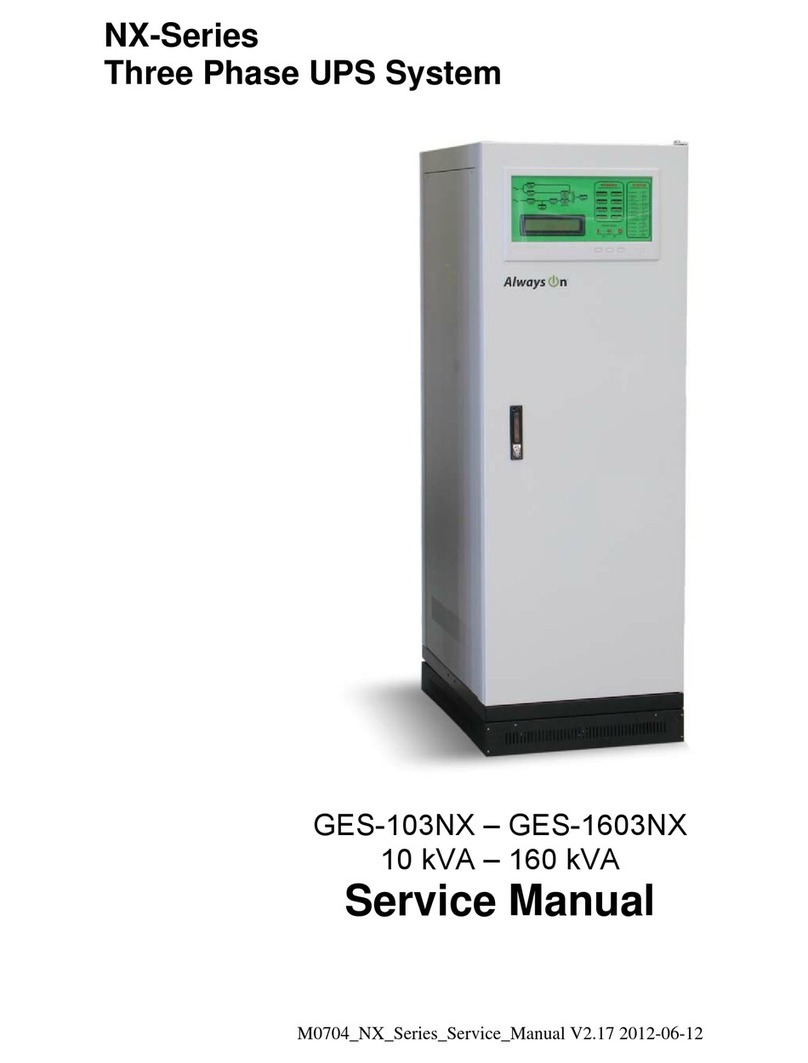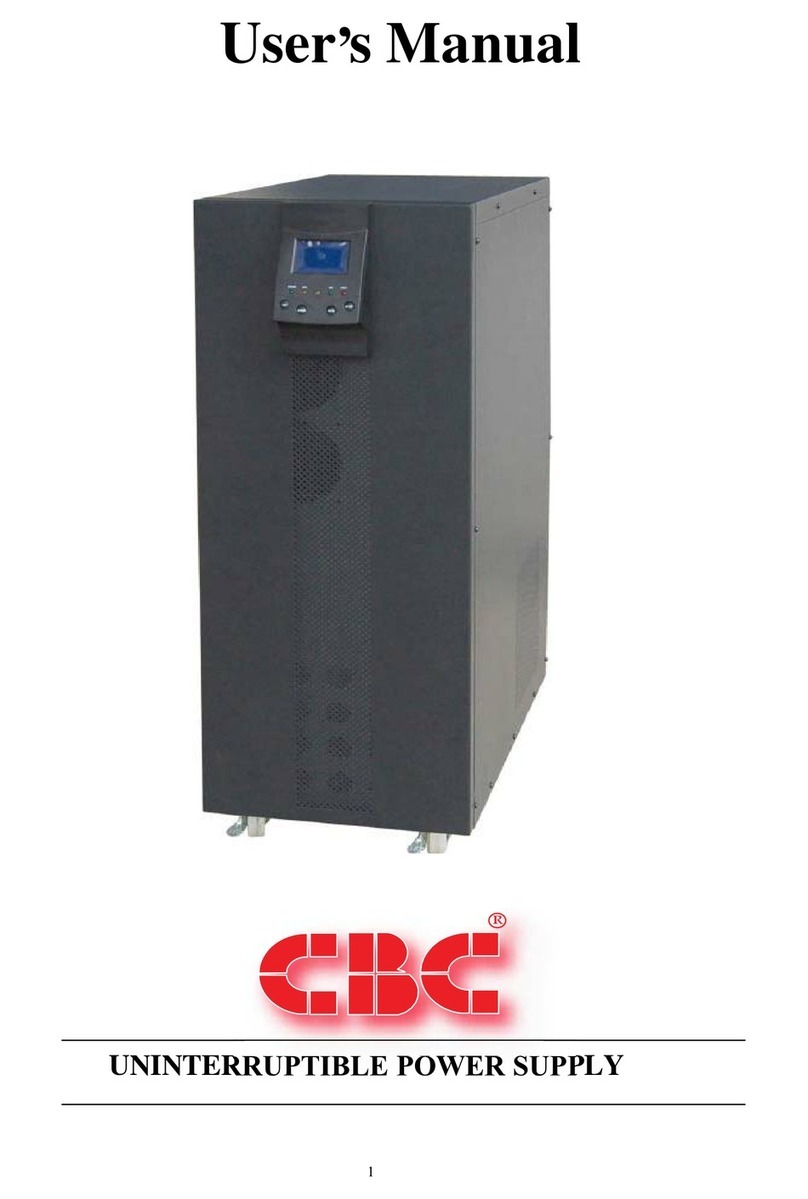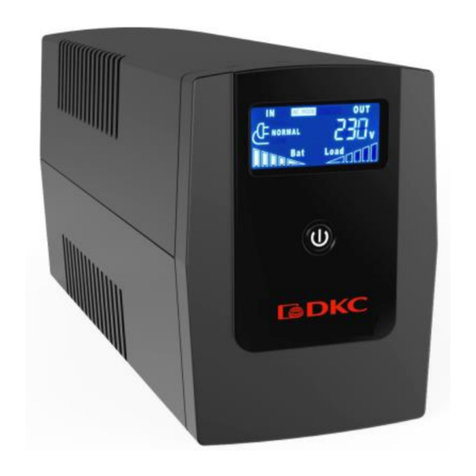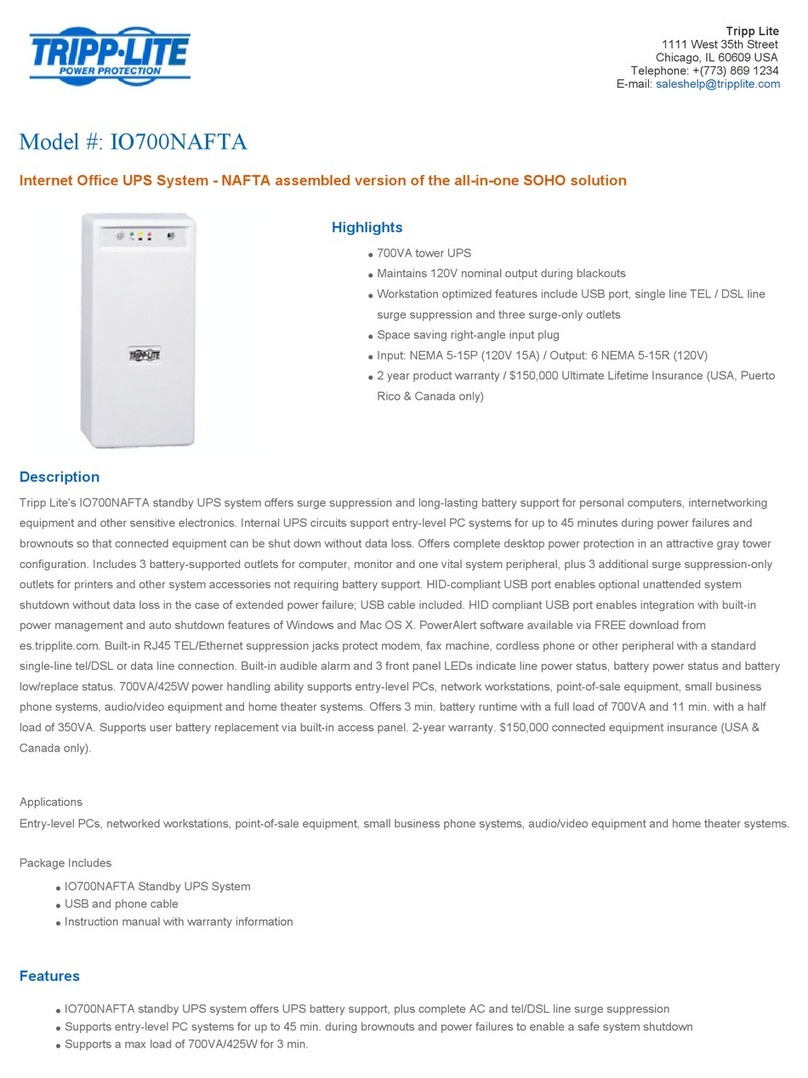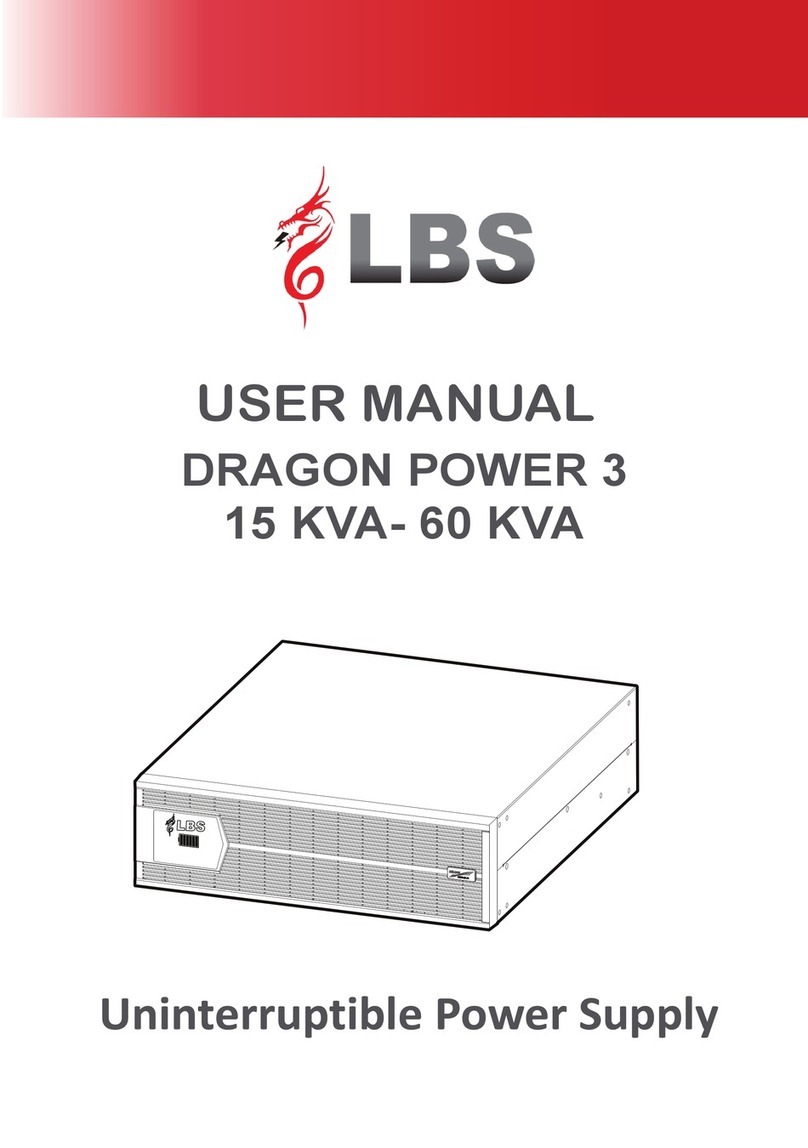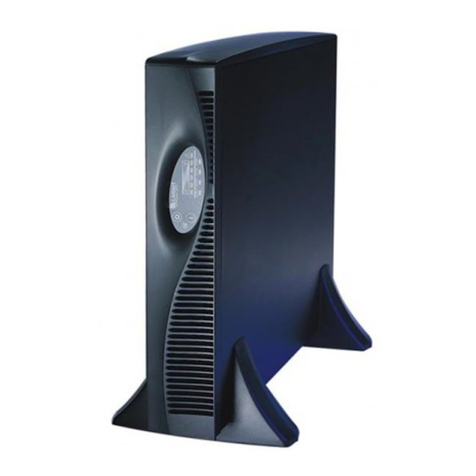Chloride Power Protection Active 700 User manual

UK

1
Chloride Active
UK

1
Chloride Active
ENGLISH
DEUTSCH
ESPAÑOL
FRANÇAIS
ITALIANO
PORTUGUÊS
UK
DE
E
FR
I
P

2
Chloride Active
945044.066
All rights, including rights of translation,
reproduction by printing, copying or similar
methods even by printing, are reserved.
Offenders will be liable for damages.
All rights, including rights created by patent
grant of registration of utility model or design,
are reserved.
Delivery subject to availability. Right of
technical modification reserved.
Reservados todos los derechos, incluso el
derecho de la traducción completa o parcial,
la reimpresión, la reproducción por copias
o por otros métodos análogos.
Las infracciones darán derecho a una
indemnización por daños sufridos.
Reservados todos los derechos especial-
mente en caso de la concesión de patentes
o de modelos de utilidad.
Entrega sometida a disponibilidad.
Reservado el derecho de establecer
modificaciones técnicas.
Alle Rechte vorbehalten, insbesondere (auch
auszugsweise) die der Übersetzung, des
Nachdrucks und Wiedergabe durch Kopieren
oder ähnliche Verfahren. Zuwiderhanlungen
verpflichten zu Schadenersatz.
Alle Rechte vorbehalten, insbesondere für
den Fall der Patenterteilung oder der GM-
Eintragung.
Lieferung je nach Verfügbarkeit. Technische
Änderungen vorbehalten.
Tutti i diritti, incluso quelli di traduzione,
riproduzione di stampa, copia, concessione
di licenze e di utilizzo e simili, anche solo di
parti del testo, sono riservati.
I trasgressori seranno perseguiti per
danni.
La consegna è soggetta alla disponibilità.
L’azienda si riserva il diritto di variare
qualunque informazione tecnica riportata.
Todos os direitos reservados, em especial o
direito de traduçao (também parcialmente),
reproduçao, completa ou de partes
por reimpressão, cópias ou métodos
similares.
Os infratores estarão sueitos a ressarcir
os prejuicios.
Todos os direitos reservados, incluindo
a concessão de patentes e utilizaçao
de modelos. Entregas são sujeitas à
disponibilidade. Reservados os direitos de
realizar modificaçoes técnicas.
Touts droits réservés, y compris pour la
traduction, la réproduction même partielle par
impression, photocopie ou autres méthodes
analogues.
Les infractions sont passibles de
poursuites.
Tous droits réservés, y compris ceux issus de
l’attribution d’un brevet ou de l’enregistrement
d’un modéle ou d’un dessin d’utilité.
Livraison en fonction des disponibilités.
Siemens se réserve le droit d’apporter des
modifications sans préavis.
UK DE
E FR
I P

3
Chloride Active
UK
UK
DE
E
FR
I
P
OPERATING MANUAL
BEDIENUNGSANLEITUNG
MANUAL DE USUARIO
MANUAL UTILISATEUR
MANUALE D’USO
MANUAL DE INSTRUÇÕES
4
42
80
118
156
194

4
UK
Chloride Active
945044.066
1. Safety
1.1 Intended use
1.2 General Warnings
1.3 Safety Notices
1.4 Battery Safety
1.5 Environmental Considerations
1.6 Notices Regarding the EU Declaration of Conformity
1.7 Repacking of Unit
2. About This Manual
2.1 Introduction
2.2 Device Overview
2.3 Symbols
2.4 Documentation Structure
3. Setup and Installation
3.1 Delivery
3.2 Unpacking
3.3 Scope of Delivery
3.3.1 Tower Units (UPS)
3.3.2 Tower Units (Battery Packs)
3.3.3 Rack/Tower Units (UPS)
3.3.4 Rack/Tower Units (Battery Packs)
3.4 Storage
3.5 Handling
3.6 Environmental Conditions
3.7 Floor Loading
3.8 Rack Loading
3.9 Ventilation
3.10 Installation Data
3.11 Rack-Mounting the UPS or External Battery Cabinets (RT Models Only)
3.12 Floor-Mounting the UPS or External Battery Cabinets (RT Models Only)
3.12.1 Mounting the UPS Only
3.12.2 Mounting the UPS plus One External Battery
4. Operation and Commissioning
4.1 Theory of Operation
4.1.1 Line Mode
4.1.2 Battery Mode
4.1.3 Bypass Mode
4.1.4 ECO Mode
4.1.5 Frequency Converter Mode
4.1.6 Other Operating Details
4.1.7Block Diagram
4.2 Front Panel Indicators and Operating Elements Description
4.2.1Units with LED Indicators
4.2.1.1 Description of the elements
4.2.1.2 Operation
4.2.1.3 Indicators
4.2.2Units with LCD Display
4.2.2.1 Menus and Functionalities
4.2.2.2 Warnings and Fault Indicators
4.3 Rear Side
4.3.1Tower Units
6
6
6
6
7
7
8
8
9
9
9
10
10
11
11
11
11
11
11
11
12
12
12
12
13
13
13
13
13
15
15
15
16
16
16
16
16
16
16
17
17
18
18
18
19
20
21
22
24
24
24

5
Chloride Active
UK
4.3.2 Rack/Tower Units
4.4Commissioning and Shutdown
4.4.1 Electrical Preparations
4.4.2 Connections
4.4.2.1 External Battery Packs Connection
4.4.2.2 Power Connections
4.4.3 Start-Up Procedure
4.4.3.1 Initial UPS Start-Up Procedure
4.4.3.2 Normal Start-Up Procedure
4.4.4 Forced Bypass Procedure
4.4.5 ECO Mode Activation/Deactivation Procedure
4.4.6 Frequency Converter Mode Procedure
4.4.7 UPS Shutdown Procedure
4.4.8 Remote Power Off (RPO) / Remote On Off (ROO)
5. Communication Interfaces
5.1 Serial Interface
5.2 DB9 Port
5.3 USB Port
5.4 Interface Slot
6. Maintenance
6.1 Cleaning
6.2 UPS Storage
6.3 Battery Testing
6.4 Battery Replacement
6.4.1 Replacing the UPS internal batteries
6.4.2 Battery Disposal
6.5 Front Panel with LCD Display Installation
7. Troubleshooting
8. Technical Specifications & Runtime Charts
8.1 Specifications
8.1.1 Uninterruptible Power Supplies
8.1.2 Battery Packs
8.2 Runtime Charts
26
27
27
27
27
28
28
28
29
29
29
30
30
30
31
31
31
32
32
33
33
33
33
33
33
35
35
37
38
38
38
40
40

6
UK
Chloride Active
945044.066
1. Safety
1.1 Intended use
This unit serves as an uninterruptible power supply (UPS) for connected loads. The unit is in compliance with all
relevant safety regulations concerning information technology equipment, for use in an office environment.
Depending on the type and rating of the UPS unit, certain configurations of battery extensions may be connected.
These battery packs may only be connected to the compatible basic UPS unit.
1.2 General Warnings
WARNING: We consider the safety of personnel to be of paramount importance. For this reason, it is essential
that procedures relating to safety in this manual be carefully reviewed before commencing work, and properly
adhered to thereafter. The User or Operator may intervene in the operation of the UPS provided that the
instructions laid out in the section 3 (“Setup and Installation”) are strictly followed.
WARNING: Even when all switches and/or circuit breakers are open, dangerous voltages are present within this
unit. There are no user-serviceable parts inside. Only factory authorized personnel may carry out any operation
that requires protection panels to be opened and/or removed. Any repairs or modifications by the user may
result in out-of-warranty repair charges, unsafe electrical conditions or violation of electrical codes.
WARNING: In order to comply with UL requirements, a disconnection device shall be available at the UPS
output (note: the output plug can be considered as a disconnection device).
WARNING: In order to comply with UL requirements; to reduce the risk of fire, connect the UPS input only
to a circuit provided with branch circuit overcurrent protection for 20 amperes rating in accordance with the
National Electric Code, ANSI/NFPA 70)
1.3 Safety Notices
WARNING: Read the following safety notices carefully! Disregard of these safety notices may endanger your
life, your health, the reliability of your unit and the security of your data.
- Transport the unit only in suitable packaging (protected against jolts and shocks).
- If the UPS is moved from a cold environment to a warmer operating location, condensation may occur. Before
you switch on the unit it must be absolutely dry. An acclimatization period of at least two hours is required.
- The UPS must be installed in accordance with the environmental conditions specified in sections 3.6 and
3.10.
- Even with all buttons in “OFF” position, the unit (UPS) is not isolated from the mains. To isolate completely
from the mains, the input power cord must be disconnected.
- This unit services power from more than one source. The output terminals and/or receptacles may have
voltage present even when the unit is unplugged. UPS’s present a different safety issue than most electrical
equipment because unplugging the unit puts it into battery mode. Unplugging the UPS does not remove
electrical charge.
- In case of interruption of the mains voltage, the integrated battery maintains the power supply to the user’s
equipment.
- Place all cords so that nobody can stand on them or trip over them. When connecting the unit to the power
supply, follow the instructions in section 3 (“Setup and Installation”).
- Make sure that no objects (e.g. necklaces, paper clips, etc) get inside the unit.
- In emergencies (e.g. damaged case, controls or power cables, penetration of liquids or foreign bodies) switch
off the unit, disconnect from mains and contact the responsible customer service representative.
- Do not connect equipment that will overload the UPS or demand DC current.
- When cleaning the unit, follow the instructions in section 6 (“Maintenance”).
- Data transmission lines should not be connected or disconnected during a thunderstorm.
- The sum of the leakage currents (currents in the earth conductor) from the UPS and connected loads must
not exceed the value of 3.5 mA.
- Remote Power Off (RPO) and Remote On Off (ROO) terminals are located on the rear side of the unit (see
section 4.4.8) When the relevant connections are open, the logic circuit will immediately shut down the UPS
output.
- When installing units in racks, do not allow racks to become “top heavy”. Install heaviest equipment (typically
the UPS and batteries) near bottom of rack, and install this equipment before installing equipment higher in

7
Chloride Active
UK
the rack.
- This unit is equipped with a safety-inspected mains line and must only be connected to a grounded earthing-
contact socket.
- Make certain that the socket on the unit or the earthing contact socket of the house installation is freely
accessible.
- This is a category C2 UPS product. In a residential environment, this product may
cause radio interference, in which case the user may be required to take additional measures.
1.4 Battery Safety
WARNING: The batteries installed in the UPS and within the battery packs contain electrolyte. Under normal
conditions the containers are dry. A damaged battery may leak electrolyte that can be dangerous in contact
with the skin and cause irritation to the eyes. Should this happen, wash the affected part with copious amounts
of water and seek immediate medical advice.
- Voltage is always present on the battery terminals.
- Even when discharged, a battery has the capacity to supply a high short circuit current, which, in addition to
causing damage to the battery itself and to associated cables, may expose the operator to the risk of burns.
- Batteries should not be kept in storage for periods exceeding 6 months at 25ºC without being recharged
(having been charged to 100% at the beginning of any such period). If these conditions are not respected
the performance of the battery can no longer be guaranteed. It is advisable to recharge the batteries at least
once every 4 months.
- Since new batteries often do not provide full capacity after an initial charge it may be necessary to carry out
a number of discharge/recharge cycles before optimum performance is achieved.
- In order to protect the environment, batteries must be disposed of in accordance with the regulations governing
disposal/recycling of toxic and harmful waste.
For replacement of batteries located in a service access area:
- Servicing of batteries should be performed or supervised by personnel knowledgeable about batteries and
the required precautions.
- When replacing batteries, replace with the same type and number of batteries or battery packs.
- Do not dispose of batteries in a fire. The batteries may explode.
-Do not open or mutilate batteries. Released electrolyte is harmful to the skin and eyes. It may be toxic
- A battery can present a risk of electrical shock and high short-circuit current. The following precautions should
be observed when working on batteries:
·Remove watches, rings, or other metal objects.
·Use tools with insulated handles.
·Wear rubber gloves and boots.
·Do not lay tools or metal parts on top of batteries
·Disconnect charging source prior to connecting or disconnecting battery terminals.
·Determine if battery is inadvertently grounded. If inadvertently grounded, remove source from
ground. Contact with any part of a grounded battery can result in electrical shock. The likelihood
of such shock can be reduced if such grounds are removed during installation and maintenance
(applicable to equipment and remote battery supplies not having a grounded supply circuit).
1.5 Environmental Considerations
This unit contains batteries. Their disposal should be made in accordance with the applicable legislation in
your country.
The lead and acid contained by the batteries can be harmful for the environment.
The units should be disposed of at the end of their lifetime in accordance with the applicable legislation in
your country.
We take into consideration environmental aspects as a part of the design of our units, trying to minimize their
environmental impact. This implies using those technological advantages that allow reduction of the use of
hazardous substances and the generation of toxic and dangerous residues.
This manual includes recommendations created to optimize the operation of the unit and its components.

8
UK
Chloride Active
945044.066
1.6 Notices regarding the EU Declaration of Conformity
This unit is in conformity with the following European directives:
73/23/EWG. Directive of the council for adaptation of the legal regulations of the member states regarding
electrical equipment for use within specific voltage limits, modified by directive 93/68/EWG.
89/336/EWG. Directive of the council for adaptation of the legal regulations of the member states regarding
electromagnetical compatibility, modified by directive 91/263/EWG, 92/31/EWG and 93/68/EWG.
Conformity is established through compliance with the following standards:
-EN 62040-1-1
-EN 62040-2
Additional information regarding adherence to these directives is included in the appendices NSR and EMC
of the EU Declaration of Conformity.
If needed, the EU Declaration of Conformity can be requested from the manufacturer.
1.7 Repacking of Unit
Do not pack the unit until at least two hours have elapsed since the last recharge.
Place the equipment in bags made of a material sufficiently porous to allow it to breathe (e.g. 100μm
polyethylene).
Do not remove air from the packaging.
When packing unit for movement by common carrier, place in original or equivalent packaging container.

9
Chloride Active
UK
2 About This Manual
2.1 Introduction
This manual contains information regarding the installation, operation and use of the Uninterruptible Power
Supply (UPS).
Consult this manual before installation of the equipment. This manual should be kept for later reference for
operation and maintenance of the UPS.
2.2 Device Overview
These UPS units are delivered with various nominal powers and in various housings.
The following table provides an overview of the various versions of the unit:
Depending on your local market, these units can include a front panel based on LED indicators or a front
panel with a LCD Display.
For units which include a front panel based on LED indicators as standard, front panels with LCD display are
available as accessory. These front panels have to be ordered separately. Installation of the front panel with
LCD display must be carried out by qualified technicians. Please contact the responsible customer service
representative. For further details on installation, please see section 6.5.
The following battery packs are available:
Housing Designation Nominal Power
Tower
(upright unit)
Active 700 T 700 VA
Active 1000 T 1000 VA
Active 1500 T 1500 VA
Rack/Tower convertible
(can be upright or rack-
mounting unit)
Active 1000 RT 1000 VA
Active 1500 RT 1500 VA
Active 2000 RT 2000 VA
Active 3000 RT 3000 VA
Housing Designation Compatible UPS Unit
Tower
(upright unit) BP-A1000/1500 T Active 1000 T
Active 1500 T
Rack/Tower convertible
(can be upright or rack-
mounting unit)
BP-A1000/1500 RT Active 1000 RT
Active 1500 RT
BP-A2000/3000 RT Active 2000 RT
Active 3000 RT

10
UK
Chloride Active
945044.066
2.3 Symbols
ATTENTION: Indicates instructions, which if not observed, may endanger reliability of your UPS or the security
of your data.
WARNING: Indicates instructions, which if not observed, present risk of electric shock, may endanger your
life, your health, reliability of your UPS or the security of your data.
NOTE: Indicates instructions and comments that provide further details on the UPS and complement the
main text.
2.4 Documentation structure
These instructions can be supplemented with additional sheets, which e.g. describe specific extensions or
options.

11
Chloride Active
UK
3 Setup and Installation
3.1 Delivery
This unit has been thoroughly checked before shipment. Upon receipt, check the packaging and ensure that
the contents are undamaged. Any damage must be reported to the shipper and any missing parts must be
reported to the supplier immediately.
3.2 Unpacking
Care should be taken when removing the packaging in order to avoid damaging the unit. Check all packaging
materials to ensure that no items are discarded (please see below figures). Note that they are only descriptive
figures whose content is subject to changes according to local markets.
3.3 Scope of delivery
The following items are included within the packaging:
3.3.1 Tower units (UPS)
- 1 x this user manual
- 1 x UPS unit
- 1 x quickstart guide
- 1 x CD with user software
- 2 x connection cables IEC320 C14 (male) - IEC C13 (female) for the UPS output
- 1 x RS232 interface cable
- 1 x USB cable
3.3.2 Tower units (Battery Packs)
- 1 x Battery Pack unit
- 1 x battery extension cable
- 1 x battery pack detection cable for auto-detection of number of battery packs connected
3.3.3 Rack/Tower units (UPS)
- 1 x this user manual
- 1 x UPS unit
- 1 x quickstart guide
- 1 x CD with user software
- Connection cables as per below:
1 and 1.5kVA rack/tower units 2 and 3kVA rack/tower units
Tower units

12
UK
Chloride Active
945044.066
- 1 x RS232 interface cable
- 1 x USB cable
- 2 x front brackets for rack-mounting and required mounting hardware
- 2 x sets of tower feet for floor-mounting
- 2 x sliding rail kits for rack-mounting (optionally) and required mounting hardware
3.3.4 Rack/Tower units (battery packs)
- 1 x Battery Pack unit
- 1 x battery extension cable
- 1 x battery pack detection cable for auto-detection of number of battery packs connected
- 2 x front brackets for rack-mounting and required mounting hardware
- 2 x spacers to be assembled with the sets of tower feet for floor-mounting
- 1 x plate for securing the battery pack to the UPS for floor-mounting
- 2 x sliding rail kits for rack-mounting (optionally) and required mounting hardware
3.4 Storage
If it is not intended that the UPS be used within seven days of delivery, attention shall be paid to the storage
conditions.
The UPS should be stored in a clean, dry environment and away from temperature extremes. It is
recommended that the unit be stored in a temperature controlled, moderate humidity environment. The
table below provides the temperature and humidity storage limits:
3.5 Handling
The UPS must be kept upright at all times and handled with care. Damage may be caused if dropped or
subjected to severe impact.
3.6 Environmental Conditions
The UPS tower version must be installed vertically. The UPS rack/tower version (RT hereinafter) can be
installed vertically or horizontally, depending on the desired arrangement.
In any case, it must be installed on a level and even surface and in an area protected from extremes of
temperature, water, humidity and the presence of conductive powder or dust (see section 3.10). Do not
stack units and do not place any objects on top of a unit.
The functional temperature range of the UPS is specified in section 8 (“Technical Specifications”).
The ideal ambient temperature range is 15ºC to 25ºC.
Expected battery runtimes and battery life is defined at 20ºC. Increments of temperature above 25ºC will
reduce the expected battery life.
1000, 1500 and 2000VA models 3000VA models
2 x connection cables IEC320
C14 (male) - IEC C13 (female)
for the UPS output
1 x connection cable Schuko
(male) - IEC320 C19 (female) for
the UPS input
1 x multisocket extension
IEC320 C20 (male) - 3 x Schuko
(female) for the UPS output
Temperature limits -25ºC/50ºC (w/o batteries)
-15ºC/40ºC (with batteries)
Relative humidity (non-
condensing) 10-90%

13
Chloride Active
UK
3.7 Floor Loading
Taking into consideration the weight of the UPS and extension battery packs of Tower models and RT
models operating as Tower, it is necessary that the floor in the chosen location be capable of supporting the
weight of the units.
NOTE: Weights for the UPS and battery packs are shown in section 8 (“Technical Specifications”).
3.8 Rack Loading
Taking into consideration the weight of the UPS and extension battery packs of RT models that may be
mounted in an associated rack, it is necessary that the chosen cabinet be capable of supporting the weight
of the units.
NOTE: Weights for the UPS and battery packs are shown in section 8 (“Technical Specifications”).
3.9 Ventilation
It is necessary to leave a minimum space of at least 50 mm in front and rear of the UPS to allow a flow of
air.
Electrical maintenance and servicing requires access to the front and back of the UPS. Provide the
necessary space to allow service personnel access to the UPS.
3.10 Installation Data
3.11 Rack-Mounting the UPS or External Battery Cabinets (RT Models Only)
The Rack/Tower UPS’s and external battery packs can be rack-mounted in four-post frames. The UPS and
external battery packs use identical mounting hardware and the procedure for mounting either is the same.
ATTENTION: The UPS draws cooling air from the front. If the rack has a door on the front, make sure that
there is some clearance between the vents and the rack door.
Because of the weight and dimensions of these units (particularly the 2 and 3kVA models), it is strongly
recommended that two people lift the unit for rack-mounting. If only one person is available, it may be
possible to disconnect and take out the UPS internal batteries, rack-mount the UPS without batteries (less
weight) and re-connect the internal batteries once that the UPS is rack-mounted.
Item Specification
Ambient temperature 0ºC to 40ºC
Relative humidity (non condensing) 20%-90%
Environment Controlled (office or similar)
Max. altitude (w/o derating) 3.000 meters
Input power connection Rear
Output power connection Rear
Battery power connection Rear
Air inlet Front
Air outlet Rear

14
UK
Chloride Active
945044.066
Please use only the supplied fasteners to attach the supplied mounting brackets to the UPS or external
battery packs.
If external battery packs are included in your installation, please mount them first and as low as possible.
Start with the lowest available position and work up. Your UPS should be installed last and end up on the
top of all the battery units for proper cable routing.
ATTENTION: Use all supplied mounting hardware on each UPS and external battery pack. NEVER depend
on lower devices to support other devices.
All mounting materials are available (bundled or optionally) to install the UPS into a rack. To prepare the
UPS and external batteries for use in a rack configuration, first install the sliding rails (optional accessory),
and then install the UPS and batteries following the steps below:
1. Attach rear of rails to rear of rack with two screws provided
2. Attach front of rails to front of rack with one screw provided
3. Assemble side rails and secure each rail together with three screws
4. Attach front brackets to each side of UPS with four screws on each side
5. Slide UPS into position in the rack and secure with two screws on each side of UPS
6. Attach rail to rear side of the UPS (fixing point for safer transportation)
7. Repeat the above steps for each UPS or battery pack to be mounted
After mechanical installation is complete, please read section 4 for proper commissioning and operation of
the system.

15
Chloride Active
UK
3.12 Floor Mounting the UPS or External Battery Cabinets (RT Models Only)
The RT UPS and external battery packs are designed to be floor standing as an alternative to rack
mounting.
NOTE: (only for units with front
panel with LCD display). The
LCD Display can be rotated to
the adequate position when it is
floor-mounted as illustrated in the
next figure.
ATTENTION: Use all supplied
mounting hardware on each UPS
and external battery
After mechanical installation is
complete, please read section
4 for proper commissioning and
operation of the system.
3.12.1 Mounting the UPS
only
Assemble the two sets of feet
included with the UPS and place
the UPS between feet as shown
in the next figures.
3.12.2 Mounting the UPS
plus One External Battery
Assemble the two sets of feet
with the spacer provided and
place the UPS and battery pack
between feet as shown in the
next figure. Then secure UPS
and battery pack with plates and
screws provided.

16
UK
Chloride Active
945044.066
4 Operation and Commissioning
4.1 Theory of Operation
ATTENTION: This UPS is supplied with standard power cords and receptacles suitable for its use in your
area of operation. It may be installed and operated by non-technician personnel.
4.1.1 Line Mode
In use, the UPS is connected between AC input power and the load. The operation of this UPS is based
on the on-line double conversion principle in which the input AC power is first converted to DC, and
secondarily converted back to a sine wave of a fixed frequency and voltage to supply controlled power
to the load. This UPS topology is used to prevent the critical load from suffering a variety of power line
problems, including the total loss of input AC power.
4.1.2 Battery Mode
In the event of a mains failure, the maintenance-free batteries will continue to provide an uninterrupted
supply of energy to the load. In practice, most mains failures are of relatively short duration. Therefore,
the energy stored in the UPS’s batteries is, in most cases, sufficient to ensure continuous operation of the
connected systems until the mains power is re-established. In the event of a long lasting mains failure, the
UPS can be utilized with shutdown software to enable a controlled shutdown of connected systems.
The most reliable method for determining the estimated battery runtime is the use of the LCD Display or the
application of the user software or SNMP network card. With this software, the estimated remaining battery
capacity is indicated before and during an AC power failure. These products also allow for automated
shutdown procedures that can shut down the attached devices after safely closing open applications
programs and the operating system. After return of the mains voltage, the UPS automatically restores
power to the connected equipment and starts recharging the batteries.
4.1.3 Bypass Mode
If the UPS is in bypass mode, the load is supplied directly from the AC mains via the internal automatic
bypass.
The unit automatically starts up in bypass when it is connected to the AC mains, supplying voltage
immediately to the load. It is necessary to press the Inverter ON button to start the inverter and switch the
unit to line mode (normal operation).
In the event of an overload on the UPS or internal UPS failure, the load is immediately supplied directly
from the mains via this automatic internal bypass. As soon as normal status is re-established, an automatic
switch over to inverter operation is performed.
Alternatively, the unit can be forced to bypass by the user using the front panel buttons or LCD Display.
In this case, if the input parameters (voltage, frequency) go out of tolerances, the unit automatically shuts
down.
4.1.4 ECO Mode
When the ECO Mode is enabled and mains conditions are within tolerances, the output is fed directly from
the input via the internal bypass, thus achieving very high efficiency values and therefore saving energy.
When ECO mode is activated and mains conditions go out of tolerances, the unit automatically feeds the
load through the inverter to keep the load protected.
When the unit is operating on ECO mode, the internal battery charger is working. Therefore, batteries are
kept charged.
For details on how to enable/disable this mode, please refer to 4.4.5.
4.1.5 Frequency Converter Mode
The UPS can operate as a frequency converter, providing 50Hz or 60Hz (whichever is selected) to the
output when the input frequency is within the 40-70Hz range.

17
Chloride Active
UK
When the unit is operating in this mode, there is a 50% power de-rating. This means that only 50% of the
UPS nominal power can be used when operating in this mode.
If the unit is operating as a Frequency Converter, neither can ECO Mode be activated nor can the unit be
forced to Bypass Mode.
For details on how to enable/disable this mode, please refer to 4.4.6.
4.1.6 Other Operating Details
This section covers other functionalities featured by the unit. For operating details on them, please see
sections 4.2, 4.3 and 4.4.
a) Green Power Function: when the unit is on battery mode and there is no output load, the unit
automatically shuts down after five minutes for battery and energy saving.
b) Cold Start: when this functionality is enabled, the unit has the capability to start up when mains power is
not present, thus powering the load directly from the batteries.
ATTENTION: When the UPS is started for the first time, AC power must be present
c) Auto-Restart: when this functionality is enabled, the unit automatically starts up after autonomy time has
finished upon mains power comeback. Otherwise, it is necessary to start up the unit manually.
NOTE: assuming that this functionality is activated, if there is a mains failure just after the unit has
automatically started up, autonomy time will be short as the batteries have not been fully charged.
d) Site Wiring Fault detection: the unit can detect if input line and input neutral have been inverted and
report a fault in that case.
e) Battery test: the UPS can perform a battery test in two different ways: manually, upon user request, or
automatically, with a fixed interval between tests.
f) Controllable outlets: this UPS includes two groups of output controllable sockets (outlet 1 and outlet 2).
Each group can be configured to automatically shut down when the remaining battery capacity goes below
a certain value (75%, 50%, 25% or 0%) or upon user request.
ATTENTION: It is suggested that the highest priority equipment be attached to the main outlets and that
lower priority loads be attached to the controllable outlets.
g) Remote On Off (ROO) / Remote Power Off (RPO): the unit has terminals on the rear side that allow the
user to remotely shut down and start up the unit (ROO) or remotely shut down the unit without the option of
re-starting it remotely (RPO). For operating details, please see section 4.4.8.
h) Compatibility with gensets: this UPS can operate with most of the gensets available in the market.
4.1.7 Block Diagram

18
UK
Chloride Active
945044.066
4.2 Front Panel Indicators and Operating Elements Description
4.2.1 Units with LED indicators
Depending on your local market, the UPS can be equipped with a front panel containing a series of
switches and indicator LED’s that provide the operator with the current status of the UPS and the ability to
change UPS operational mode.
NOTE: for units with front panels with LED indicators, front panels with LCD display are available as an
accessory and have to be ordered separately. For operation details about them please refer to section 4.2.2
4.2.1.1 Description of the elements
The front panel contains a series of switches and indicator LEDs that provide the operator with the current
status of the UPS and the ability to change UPS operational mode:
- Inverter ON/OFF switch and LED
- A simplified block diagram of the UPS shows the current operational mode of the UPS (i.e. line mode,
battery mode, bypass mode)
- Two LED indicators show the current status (ON or OFF) of the controllable outlets 1 and 2.
- Four additional LEDs provide error status, UPS load percentage or battery charge percentage depending
on the associated front panel button status.
- Site Wiring Fault detection switch and LED
9. Outlet 1 ON/OFF LED
10. Outlet 2 ON/OFF LED
11. Bypass Mode LED
12. Line Mode LED
13. Battery Mode LED
14. Inverter ON/OFF Button
15. Inverter ON LED
1. Site Wiring Fault Detection LED
2. Battery Fault LED
3. UPS Fault LED
4. UPS Overload LED
5. Display Selection Button
6. LED Test/Alarm Reset Button
7. Site Wiring Fault E/D Button
8. Site Wiring Fault E/D LED
Other manuals for Power Protection Active 700
2
This manual suits for next models
4
Table of contents
Languages:
Other Chloride UPS manuals

Chloride
Chloride ACTIVE A0K7XAU User manual
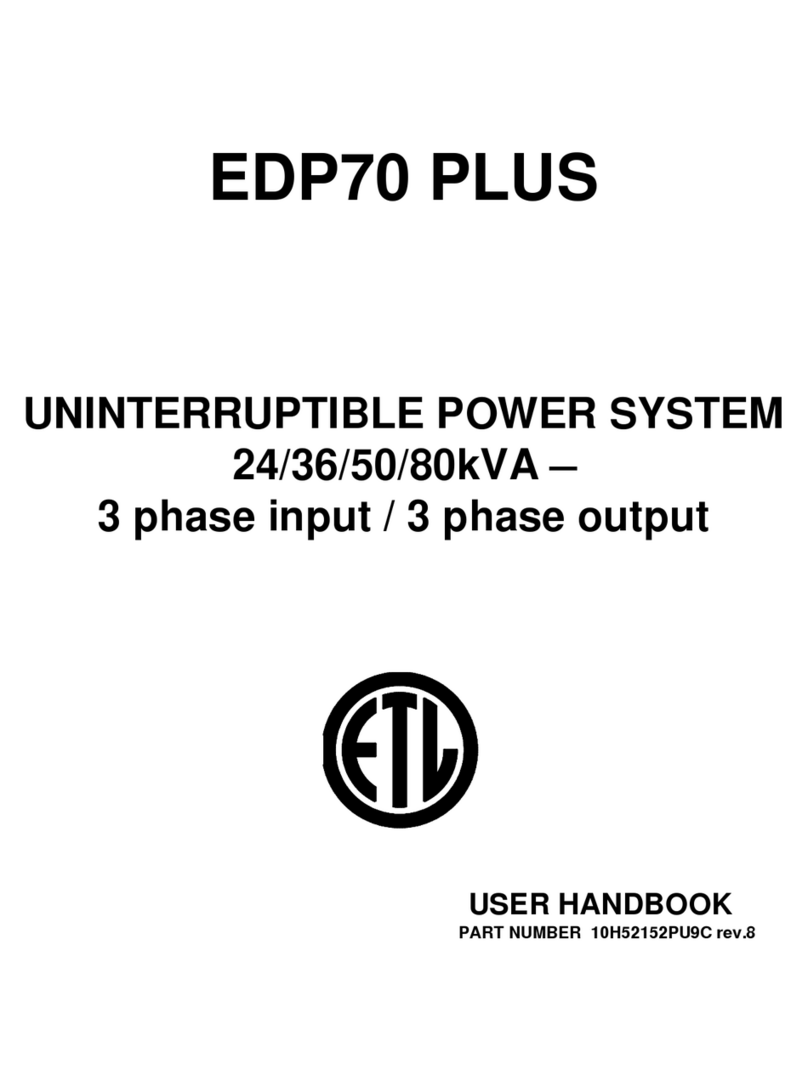
Chloride
Chloride EDP70 Instruction Manual
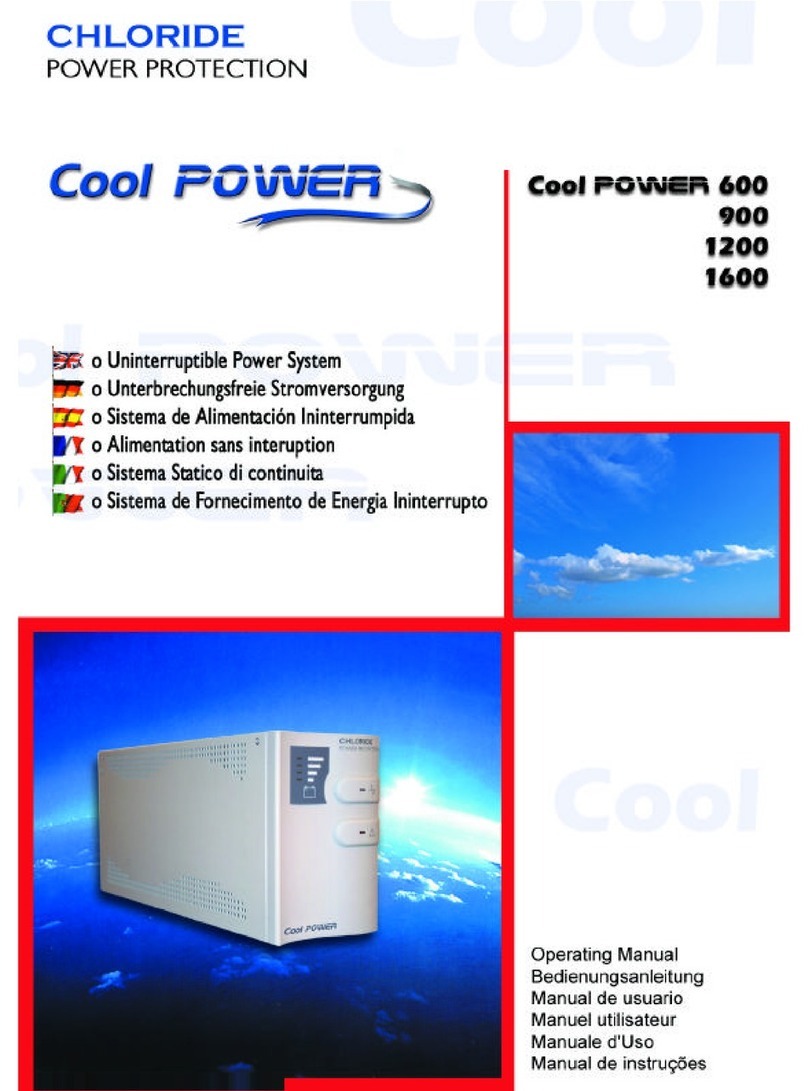
Chloride
Chloride Cool Power 600 User manual
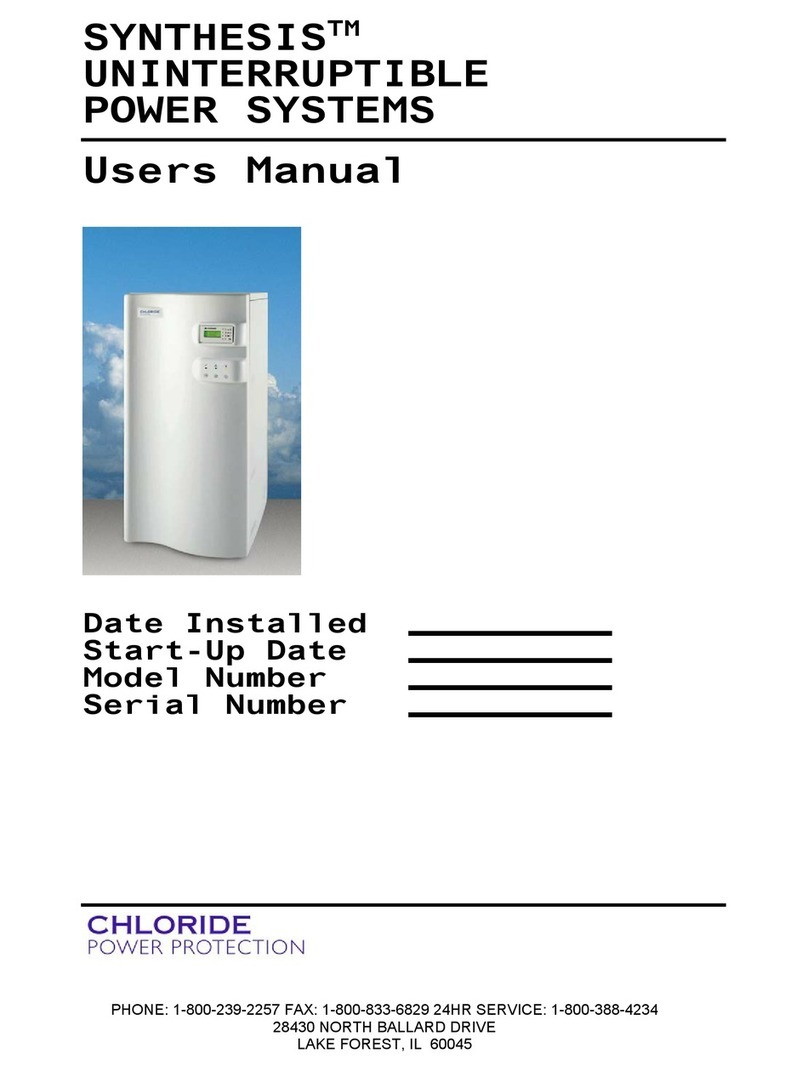
Chloride
Chloride SYNTHESIS User manual
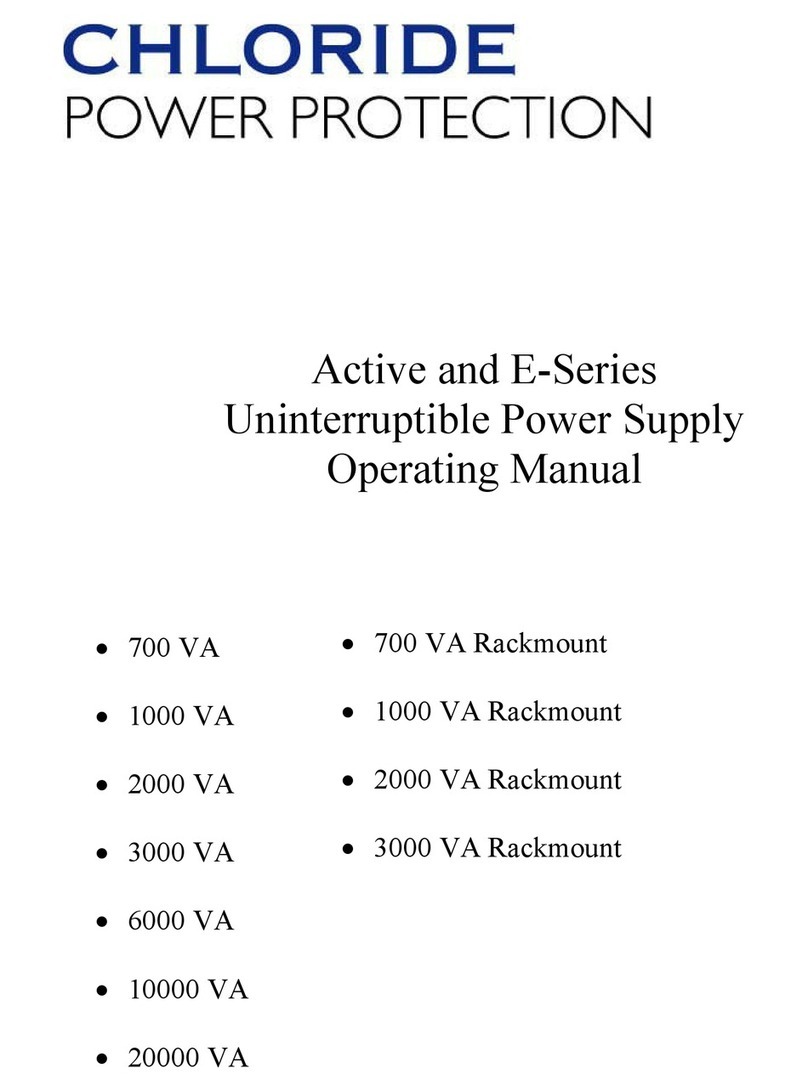
Chloride
Chloride VA 1000 Operator's manual
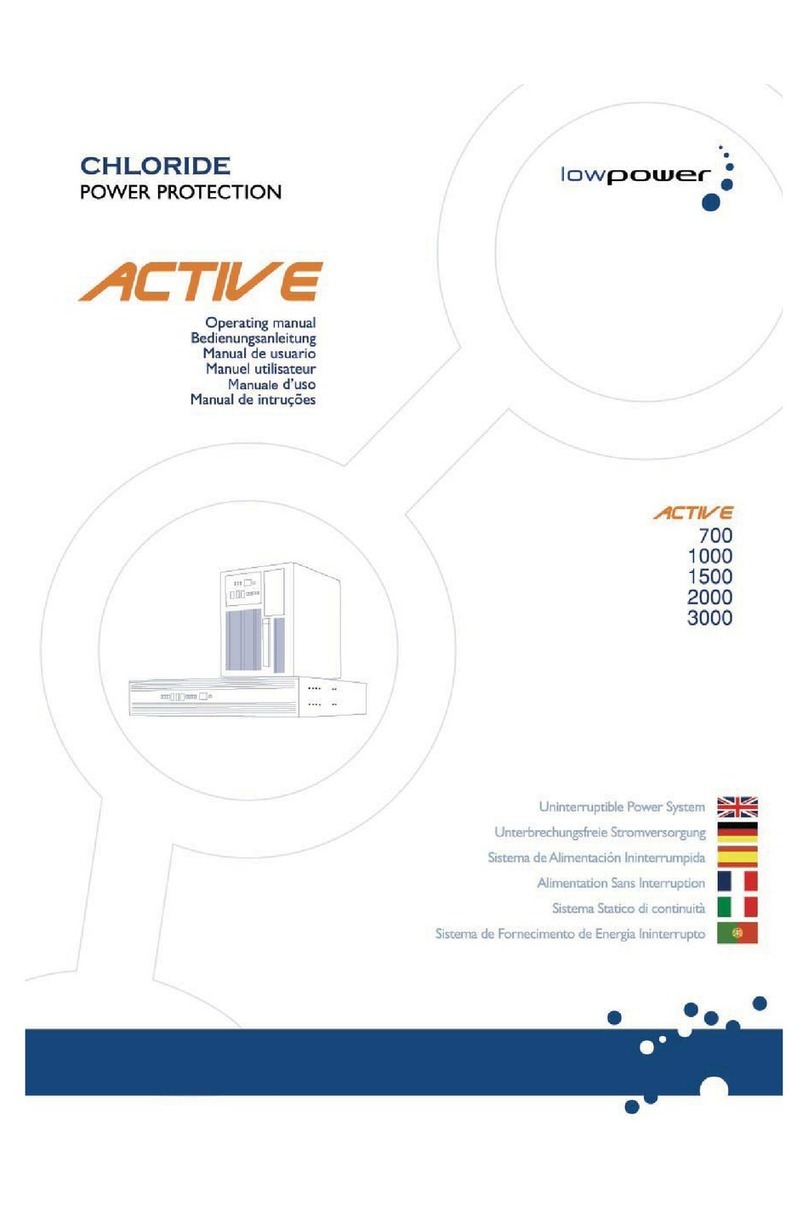
Chloride
Chloride Power Protection Active 700 User manual
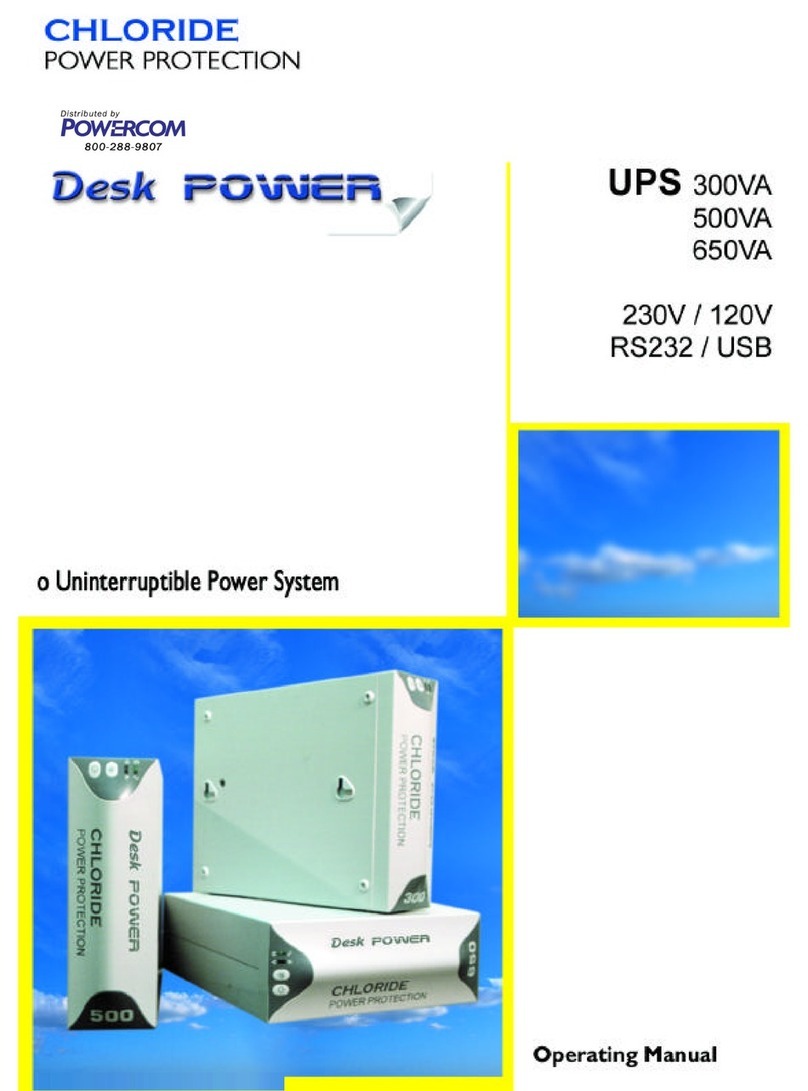
Chloride
Chloride Desk POWER 300 User manual
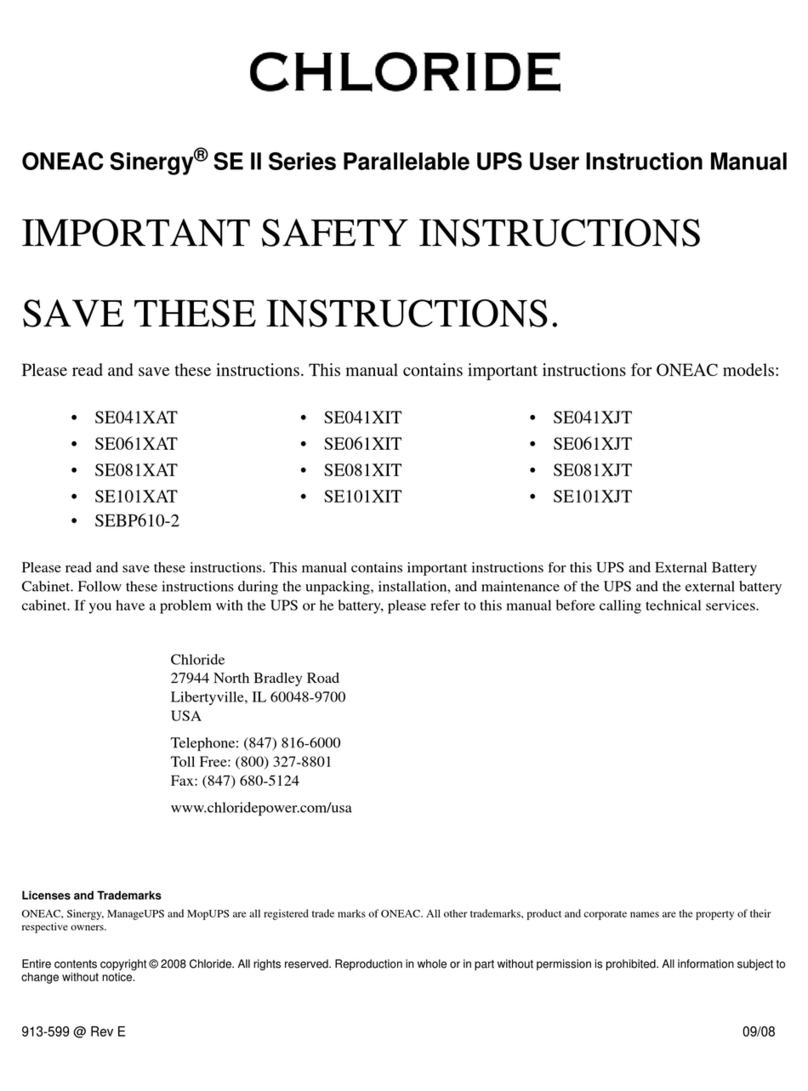
Chloride
Chloride SE041XAT Operator's manual

Chloride
Chloride EDP70 Instruction Manual

Chloride
Chloride Power Star User manual
